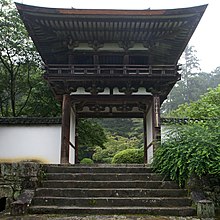Chōgaku-ji
| Chōgaku-ji | |
|---|---|
長岳寺 | |
 Chōgaku-ji's Rōmon (tower gate) | |
| Religion | |
| Affiliation | Buddhist |
| Sect | Kōyasan Shingon-shū |
| Prefecture | Nara |
| Location | |
| Municipality | Tenri |
| Country | Japan |
| Prefecture | Nara |
| Geographic coordinates | 34°33′39″N 135°51′07″E / 34.56083°N 135.85194°E |
| Architecture | |
| Founder | Kūkai |
| Date established | 824 |
| Website | |
| chogakuji | |
Chōgaku-ji (Japanese: 長岳寺) is a Japanese Buddhist temple of the Kōyasan Shingon-shū sect in the city of Tenri in Nara Prefecture, Japan.[1] It is located within Yamato-Aogaki Quasi-National Park[2] along the Yamanobe no michi (Japanese: 山辺の道), the oldest road in Japan,[3] at the foot of Mt. Ryūō in the Sanuki Mountains.[4] The temple is the fourth of the thirteen Buddhist sites of Yamato,[5] and the nineteenth of the twenty-five Kansai flower temples.[1]
History
Chōgaku-ji was built by Kūkai in 824.[6] The temple's bell tower gate (rōmon) is the oldest in Japan.[7] The gate was originally built in the Heian period when the temple was founded, and is the only building that remains of the originals at Chōgaku-ji.[8][9] The upper portion of the gate was rebuilt between 1086–1184, and the lower portion was rebuilt between 1573–1614. The gate is in a Kibitsu-zukuri-style with a thin wood shingle roof.[10]
Cultural artifacts
Chōgaku-ji has four structures and five statues that have been designated as national important cultural properties. The bell tower gate was designated a national important cultural property in 1907.[10] Jizō-in is a dō (Japanese: 堂, lit. 'hall') that was built in 1631, and was designated a national important cultural property in 1969.[11] Behind Jizō-in is it's kuri (kitchen), which was built in 1930 and was designated a national important cultural property in 1955.[12]
Gochidō is an open pagoda built between 1275–1332 in the late Kamakura period, which was designated a national important cultural property in 1908.[13] The pagoda's frame has no walls and is adorned with Sanskrit lettering, and is supported by a large central pillar (called a shinbashira).[14]
References
- ^ a b "第19番 長岳寺" [No. 19 Chōgaku-ji]. hana25.jp (in Japanese). Archived from the original on October 31, 2022. Retrieved October 30, 2022.
- ^ "大和青垣国定公園" [Yamato-Aogaki Quasi-National Park]. Nara Prefecture (in Japanese). Archived from the original on October 31, 2022. Retrieved October 28, 2022.
- ^ "Yamato: Unknown Origin" (PDF). jnto.go.jp (in French). Archived (PDF) from the original on November 15, 2022. Retrieved October 28, 2022.
- ^ Eynon, Matthew (July 30, 2012). "Chōgaku-ji Temple". JapanTravel.com. Archived from the original on October 31, 2022. Retrieved October 28, 2022.
- ^ "寺院紹介" [Introduction to the temples]. 13butu.com (in Japanese). Archived from the original on October 31, 2022. Retrieved October 28, 2022.
- ^ "長岳寺 高野山真言宗" [Chōgaku-ji – Koyasan Shingon Buddhism]. Chogakuji.or.jp (in Japanese). Archived from the original on October 31, 2022. Retrieved October 28, 2022.
- ^ "Chogakuji Temple". city.sakurai.lg.jp. Archived from the original on October 31, 2022. Retrieved October 28, 2022.
- ^ "楼門 重要文化財 (平安時代)" [Rōmon – Important Cultural Property (Heian period)]. Chogakuji.or.jp (in Japanese). Archived from the original on October 31, 2022. Retrieved October 31, 2022.
- ^ "釜口山長岳寺" [Mt. Kamaguchi's Chōgaku-ji]. Tenri City (in Japanese). October 5, 2022. Archived from the original on November 1, 2022. Retrieved November 1, 2022.
- ^ a b "長岳寺楼門" [Chōgaku-ji's Rōmon]. 国指定文化財等データベース [Database of Nationally Designated Cultural Properties] (in Japanese). Archived from the original on October 31, 2022. Retrieved October 31, 2022.
- ^ "長岳寺旧地蔵院 – 本堂" [Chōgaku-ji's Former Jizo-in – Main Hall]. 国指定文化財等データベース [Database of Nationally Designated Cultural Properties] (in Japanese). Archived from the original on November 1, 2022. Retrieved October 31, 2022.
- ^ "長岳寺旧地蔵院 – 庫裏" [Chōgaku-ji's Former Jizō-in – Kitchen]. 国指定文化財等データベース [Database of Nationally Designated Cultural Properties] (in Japanese). Archived from the original on November 1, 2022. Retrieved October 31, 2022.
- ^ "長岳寺五智堂(真面堂)" [Chōgaku-ji's Gochidō (Shinmendō)]. 国指定文化財等データベース [Database of Nationally Designated Cultural Properties] (in Japanese). Archived from the original on November 1, 2022. Retrieved October 31, 2022.
- ^ "五智呑堂 重要文化財 (鎌倉時代)" [Gochidō, important cultural property (Kamakura period)]. Chogakuji.or.jp (in Japanese). Archived from the original on November 1, 2022. Retrieved October 28, 2022.
External links
Official website (Japanese)


